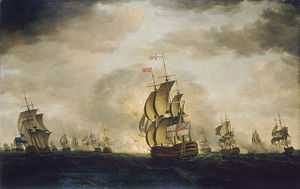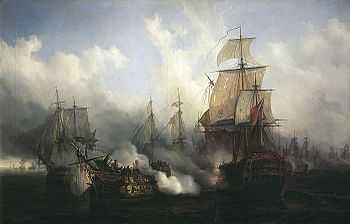HMS Sandwich (1759)
For other ships of the same name, see HMS Sandwich.
 The moonlight Battle off Cape St Vincent, 16 January 1780 by Francis Holman, painted 1780 shows the Santo Domingo exploding, with Rodney's flagship Sandwich in the foreground. | |
| Career (UK) | |
|---|---|
| Name: | HMS Sandwich |
| Ordered: | 22 November 1755 |
| Builder: | Chatham dockyard |
| Launched: | 14 April 1759 |
| Honours and awards: |
Participated in: Battle of Cape St Vincent |
| Fate: | Broken up, 1810 |
| Notes: | Floating battery from 1780; harbour service from 1790 |
| General characteristics [1] | |
| Class and type: | Sandwich-class ship of the line |
| Tons burthen: | 1869 tons bm |
| Length: | 176 ft (54 m) (gundeck) |
| Beam: | 49 ft (15 m) |
| Depth of hold: | 24 ft (7.3 m) |
| Sail plan: | Full rigged ship |
| Armament: | 90 guns: Gundeck: 28 × 32 pdrs Middle gundeck: 30 × 18 pdrs Upper gundeck: 30 × 12 pdrs Forecastle: 2 × 9 pdrs |
HMS Sandwich was a 90-gun second rate ship of the line of the Royal Navy, launched on 14 April 1759 at Chatham.[1]
Sandwich participated in the Battle of Cape St Vincent in 1780, where she served as Admiral Rodney's flagship.
She was converted to serve as a floating battery in 1780, and from 1790 she was on harbour service. Sandwich was broken up in 1810.[1]
She was Richard Parker's "flagship" in the 1797 Nore Mutiny made up of 28 ships. The ship was later used to hang the leaders of the mutiny.
Ghost ship in Trafalgar

HMS Sandwich fires into the French flagship Bucentaure (the vessel shown completely dismasted in foreground, left of center) at the battle of Trafalgar. Bucentaure also fights HMS Victory (behind her) and HMS Temeraire (left side of the picture). In fact, Sandwich did not fight at Trafalgar; her presence in this painting is due to a mistake by Auguste Mayer, the painter.[2]
Notes
- ↑ 1.0 1.1 1.2 Lavery, Ships of the Line vol.1, p175.
- ↑ Auguste Mayer's picture as described by the official website of the Musée national de la Marine (in French)
References
- Colledge, J. J.; Warlow, Ben (2006) [1969]. Ships of the Royal Navy: The Complete Record of all Fighting Ships of the Royal Navy (Rev. ed.). London: Chatham Publishing. ISBN 978-1-86176-281-8. OCLC 67375475.
- Lavery, Brian (2003) The Ship of the Line – Volume 1: The development of the battlefleet 1650–1850. Conway Maritime Press. ISBN 0-85177-252-8.